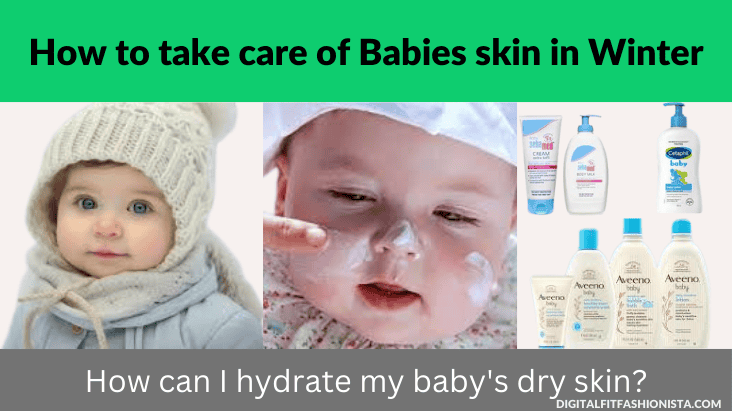Your baby’s delicate skin may suffer from the cold as winter approaches. Your baby’s skin is significantly more susceptible to severe winter weather than your own, even while the cold may cause your skin to dry out. Thankfully, you can maintain your baby’s skin hydrated, protected, and soft throughout the season by making a few easy adjustments to their skincare regimen. How to take care of Babies skin in Winter?
To assist you in taking care of your baby’s sensitive skin during winter, consider these eight useful skincare suggestions:
How to take care of Babies skin in Winter 2024
- Set a time limit for bathing
When it comes to bathing in the cold, less really is more. Frequent bathing can deplete your baby’s skin of its natural oils, leaving it dry and itchy, even though it’s still vital. Aim for only two to three baths per week, unless required, and keep them brief—ideally no more than five to ten minutes. This prevents the skin from drying out too much and helps to maintain its natural moisture content. - After taking a bath, moisturize immediately
Use a gentle towel to pat your baby dry after every bath, and while the skin is still a little wet, apply a nutritious baby lotion immediately. This keeps moisture in. Pick a mild, scent-free lotion for infants, such as oatmeal or other components that help keep skin hydrated and calm inflamed skin.

3. Use Lukewarm Water Instead
Hot water might feel cosy on a chilly winter day but damage your baby’s sensitive skin. Instead, use lukewarm water for your baby’s bath. The ideal temperature feels comfortably warm on the inside of your wrist—never too hot or too cold.
4. Oil Massage
A baby’s skin is more likely to become irritated in the winter, so oil massage helps keep it from becoming dry and flaky. Eucalyptus or mustard oil massage can relieve wintertime congestion and respiratory issues by clearing nasal passages. Your baby’s health during the winter months depends on their ability to sleep better and cope with stress, which is why an oil massage soothes them.
5. Dress in Layers for Warmth
Winter clothing can help protect your baby from the cold, but it’s important to get it right. The secret is layering: start with a comfortable sweater or shirt as the foundation layer, followed by a soft cotton onesie. For outdoor activities, top it off with a waterproof jacket or snowsuit to shield your little one from rain or snow. The goal is to keep them warm without overheating.
6. Use a Humidifier
While great for keeping your home warm, indoor heating can dry out the air and make your baby’s skin more prone to irritation. To help combat this, use a humidifier in your baby’s room. It adds moisture to the air, keeping your baby’s skin hydrated and reducing the likelihood of dry, flaky patches. It also helps with nasal congestion if your little one catches a winter cold.
7. Guard Against Wind
Wind may severely harm your baby’s delicate skin, especially if you’re outside. Use a stroller with a weather shield or cover your baby with a warm, comfortable blanket to keep their face and lips safe from the wind. If your infant is older, a little layer of mild, hydrating lip balm can also be used to prevent chapped or windburned lips.
8. Keep the infant hydrated
Even though it might not feel as hot outside in the winter, your baby still needs to drink a lot of water. Dehydration can result in dry, flaky skin. Give your infant fluids regularly to ensure they stay well hydrated. If you are nursing, continue nursing as needed.
9. Keep the temperature indoors at a comfortable level
Finding the ideal indoor temperature for your infant might be challenging because you don’t want the air to get too dry. Babies should be kept in a room between 68 and 72°F (20 and 22°C). In addition to keeping them comfortable, this will stop the air from becoming too dry from the inside heating, which could harm their skin.
How can I hydrate my baby’s dry skin?
Babies’ fragile, sensitive skin needs extra attention due to seasonal changes or environmental factors, particularly when the air is dry. Although dry skin is common among babies, there are fortunately easy ways to keep their skin safe and nourished. The following tips can help soothe and hydrate your baby’s skin.
- Use a moisturizer often
Maintaining the hydration of your baby’s skin requires regular moisturizing. It is crucial to use a lotion or cream that is hypoallergenic and fragrance-free to prevent and treat dry skin. To avoid irritation, use cosmetics designed specifically for the sensitive skin of babies.
- For Added Protection, Use Petroleum Jelly
Another great treatment for extremely dry or cracked skin areas, like your baby’s lips or cheeks, is petroleum jelly, like Vaseline or Aquaphor. By creating a barrier of defence, these products keep moisture in the skin and stop further dehydration. They fit neatly into diaper bags and are frequently offered in compact, travel-friendly sizes, making them convenient to transport. To protect the skin and promote healing, you can apply a thin coating to the afflicted areas multiple times a day, particularly during severe weather.
- Take brief, lukewarm baths
Bathing is a vital part of your baby’s routine, but you must avoid using too hot water because it might deplete the skin’s natural oils. To avoid drying out the skin, use lukewarm water and take short baths. After cleansing their skin with a gentle, fragrance-free body wash or baby soap, always moisturize to seal in moisture.
- Wear Soft, Breathable Clothes for Your Infant
Your baby’s skin health is also influenced by the clothing they wear. Select cotton or other soft, breathable materials that won’t aggravate their skin. Steer clear of clothing made of rough materials as they might make discomfort and dryness worse. By dressing your infant in layers, you can more quickly adapt to the surroundings.
The process of hydrating your baby’s skin involves several steps and calls for patience and attention to detail. You can help your infant keep soft, healthy skin by using protective items like petroleum jelly, moisturizing frequently, and controlling environmental factors like clothes and bath temperature. See your paediatrician for additional guidance and treatment if your child’s dry skin continues or gets worse.
Conclusion: How to take care of Babies skin in Winter
Your infant doesn’t have to suffer from dry, itchy skin during the winter. You can help guarantee that your baby’s skin stays soft and healthy throughout the cold months by adhering to these easy skincare guidelines: limiting bath time, moisturizing frequently, clothing in layers, and using a humidifier. Your child can have a comfortable, warm, and irritant-free winter with the correct treatment.
How to keep a baby’s face warm in winter?
Wearing soft, breathable layers and a snug cap or hood that covers their face and ears will help keep your baby’s face warm throughout the winter. Another way to shield their skin from the chilly wind is to use a light moisturizer.
What are the symptoms of winter skin in babies?
Use a soft, breathable hat that covers the chin and ears to keep your baby’s face warm throughout the winter. To protect their skin from the chilly air, use a moisturizing moisturizer.
How do you get rid of chapped cheeks in babies?
Apply a mild, fragrance-free moisturizer, such as petroleum jelly, on babies’ chapped cheeks to seal in moisture. In dry conditions, use a humidifier to keep the baby’s skin hydrated, and stay out of inclement weather.
- Is it possible to reverse skin ageing? - August 21, 2025
- How to regain motivation during burnout? - August 12, 2025
- What is a digital detox day? - July 31, 2025


